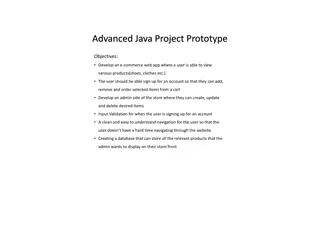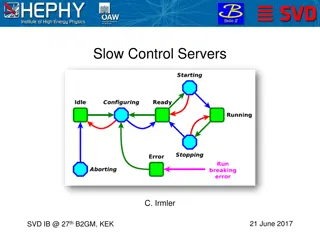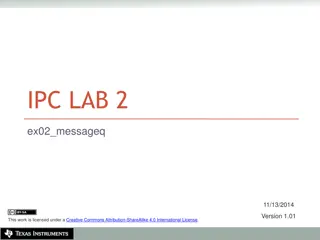
High-Performance Server Design for Network Applications
Delve into the intricacies of high-performance server design for network applications with this comprehensive presentation. Explore threaded servers, thread pool design, administration tasks, and more. Benefit from insights based on CPSC 433/533 at Yale University, courtesy of Dr. Y. Richard Yang.
Download Presentation

Please find below an Image/Link to download the presentation.
The content on the website is provided AS IS for your information and personal use only. It may not be sold, licensed, or shared on other websites without obtaining consent from the author. If you encounter any issues during the download, it is possible that the publisher has removed the file from their server.
You are allowed to download the files provided on this website for personal or commercial use, subject to the condition that they are used lawfully. All files are the property of their respective owners.
The content on the website is provided AS IS for your information and personal use only. It may not be sold, licensed, or shared on other websites without obtaining consent from the author.
E N D
Presentation Transcript
Network Applications: High-performance Server Design Qiao Xiang, Congming Gao https://sngroup.org.cn/courses/cnns- xmuf23/index.shtml 10/26/2023 This deck of slides are heavily based on CPSC 433/533 at Yale University, by courtesy of Dr. Y. Richard Yang.
Outline Admin and recap High-performance network server design o Overview o Threaded servers Per-request thread problem: large # of threads and their creations/deletions may let overhead grow out of control Thread pool Design 1: Service threads compete on the welcome socket Design 2: Service threads and the main thread coordinate on the shared queue polling (busy wait) suspension: wait/notify 2
Admin Exam 1 date: 2:30-4:10pm, Nov. 9 Assignment 3: to be posted today 3
Recap: Direction Mechanisms App DNS name1 DNS name2 IP1 IP2 IPn Cluster1 in US East Cluster2 in US West Cluster2 in Europe - Rewrite - Direct reply - Fault tolerance Load balancer Load balancer proxy servers 4
Recap: Server Processing Steps Accept Client Connection Read Request may block waiting on disk I/O may block waiting on network Find File Send Response Header Read File Send Data 5
Recap: Multi-Threaded Servers Motivation: o Avoid blocking the whole program (so that we can reach bottleneck throughput) Idea: introduce threads o A thread is a sequence of instructions which may execute in parallel with other threads o When a blocking operation happens, only the flow (thread) performing the operation is blocked 6
Background: Java Thread Model Every Java application has at least one thread o The main thread, started by the JVM to run the application s main() method o Most JVMs use POSIX threads to implement Java threads main() can create other threads o Explicitly, using the Thread class o Implicitly, by calling libraries that create threads as a consequence (RMI, AWT/Swing, Applets, etc.) 7
Recap: Per-Request Thread Server main() { ServerSocket s = new ServerSocket(port); while (true) { Socket conSocket = s.accept(); RequestHandler rh = new RequestHandler(conSocket); Thread t = new Thread (rh); t.start(); } main thread thread starts thread starts class RequestHandler implements Runnable { RequestHandler(Socket connSocket) { } public void run() { // } } thread ends thread ends Try the per-request-thread TCP server: TCPServerMT.java 8
Recap: Implementing Threads class RequestHandler implements Runnable { RequestHandler(Socket connSocket) { } public void run() { // process request } } class RequestHandler extends Thread { RequestHandler(Socket connSocket) { } public void run() { // process request } } RequestHandler rh = new RequestHandler(connSocket); Thread t = new Thread(rh); t.start(); Thread t = new RequestHandler(connSocket); t.start(); 9
Problem of Per-Request Thread: Reality High thread creation/deletion overhead Too many threads resource overuse throughput meltdown response time explosion o Q: given avg response time and connection arrival rate, how many threads active on avg? 10
Outline Admin and recap High-performance network server design o Overview o Threaded servers Per-request thread problem: large # of threads and their creations/deletions may let overhead grow out of control Thread pool 11
Using a Fixed Set of Threads (Thread Pool) Design issue: how to distribute the requests from the welcome socket to the thread workers welcome socket Thread 1 Thread 2 Thread K 12
Design 1: Threads Share Access to the welcomeSocket WorkerThread { void run { while (true) { Socket myConnSock = welcomeSocket.accept(); // process myConnSock myConnSock.close(); } // end of while } sketch; not working code welcome socket Thread 1 Thread 2 Thread K 13
Design 2: Producer/Consumer main { void run { while (true) { Socket con = welcomeSocket.accept(); Q.add(con); } // end of while } welcome socket Main thread WorkerThread { void run { while (true) { Socket myConnSock = Q.remove(); // process myConnSock myConnSock.close(); } // end of while } Q: Dispatch queue sketch; not working code Thread K Thread 1 Thread 2 14
Common Issues Facing Designs 1 and 2 Both designs involve multiple threads modifying the same data concurrently o Design 1: o Design 2: Q welcomeSocket In our original TCPServerMT, do we have multiple threads modifying the same data concurrently? 15
Concurrency and Shared Data Concurrency is easy if threads don t interact o Each thread does its own thing, ignoring other threads o Typically, however, threads need to communicate/coordinate with each other o Communication/coordination among threads is often done by shared data 16
Simple Example public class ShareExample extends Thread { private static int cnt = 0; // shared state, count // total increases public void run() { int y = cnt; cnt = y + 1; } public static void main(String args[]) { Thread t1 = new ShareExample(); Thread t2 = new ShareExample(); t1.start(); t2.start(); Thread.sleep(1000); System.out.println( cnt = + cnt); } } Q: What is the result of the program? 17
Simple Example What if we add a println: int y = cnt; System.out.println( Calculating ); cnt = y + 1; 18
What Happened? A thread was preempted in the middle of an operation The operations from reading to writing cnt should be atomic with no interference access to cnt from other threads But the scheduler interleaves threads and caused a race condition Such bugs can be extremely hard to reproduce, and also hard to debug 19
Synchronization Refers to mechanisms allowing a programmer to control the execution order of some operations across different threads in a concurrent program. We use Java as an example to see synchronization mechanisms We'll look at locks first. 20
Java Lock (1.5) interface Lock { void lock(); void unlock(); ... /* Some more stuff, also */ } class ReentrantLock implements Lock { ... } Only one thread can hold a lock at once Other threads that try to acquire it block (or become suspended) until the lock becomes available Reentrant lock can be reacquired by same thread As many times as desired No other thread may acquire a lock until it has been released the same number of times that it has been acquired Do not worry about the reentrant perspective, consider it a lock 21
Java Lock Fixing the ShareExample.java problem import java.util.concurrent.locks.*; public class ShareExample extends Thread { private static int cnt = 0; static Lock lock = new ReentrantLock(); public void run() { lock.lock(); int y = cnt; cnt = y + 1; lock.unlock(); } } 22
Java Lock It is recommended to use the following pattern lock.lock(); try { // processing body } finally { lock.unlock(); } 23
Java synchronized This pattern is really common Acquire lock, do something, release lock after we are done, under any circumstances, even if exception was raised, the method returned in the middle, etc. Java has a language construct for this synchronized (obj) { body } Utilize the design that every Java object has its own implicitly lock object, also called the intrinsic lock, monitor lock or simply monitor Obtains the lock associated with obj Executes body Release lock when scope is exited Even in cases of exception or method return 24
Discussion object o o s lock An object and its associated lock are different ! Holding the lock on an object does not affect what you can do with that object in any way Examples: synchronized(o) { ... } // acquires lock named o o.f (); // someone else can call o s methods o.x = 3; // someone else can read and write o s fields o o o 25
Synchronization on this class C { int cnt; void inc() { synchronized (this) { cnt++; } // end of sync } // end of inc } C c = new C(); Thread 1 c.inc(); Thread 2 c.inc(); A program can often use this as the object to lock Does the program above have a data race? No, both threads acquire locks on the same object before they access shared data 26
Synchronization on this class C { static int cnt; void inc() { synchronized (this) { cnt++; } // end of sync } // end of inc C c = new C(); Thread 1 c.inc(); Thread 2 c.dec(); void dec() { synchronized (this) { cnt--; } // end of sync } // end of dec } Does the program above have a data race? No, both threads acquire locks on the same object before they access shared data 27
Example See o ShareWelcome/Server.java o ShareWelcome/ServiceThread.java 28
Discussion You would not need the lock for accept if Java were to label the call as thread safe (synchronized) One reason Java does not specify accept as thread safe is that one could register your own socket implementation with ServerSocket.setSocketFactory Always consider thread safety in your design o If a resource is shared through concurrent read/write, write/write), consider thread-safe issues. 29
Why not Synchronization Synchronized method invocations generally are going to be slower than non-synchronized method invocations Synchronization gives rise to the possibility of deadlock, a severe performance problem in which your program appears to hang 30
Synchronization Overhead Try SyncOverhead.java 31
Synchronization Overhead Try SyncOverhead.java Method Time (ms; 5,000,000 exec) no sync 8 ms synchronized method 18 ms synchronized on this 18 ms lock 89 ms lock and finally 88 ms 32
Design 2: Producer/Consumer main { void run { while (true) { Socket con = welcomeSocket.accept(); Q.add(con); } // end of while } welcome socket Main thread WorkerThread { void run { while (true) { Socket myConnSock = Q.remove(); // process myConnSock myConnSock.close(); } // end of while } How to turn it into working code? Q: Dispatch queue Thread K Thread 1 Thread 2 33
Main main { void run { while (true) { Socket con = welcomeSocket.accept(); Q.add(con); } // end of while } main { void run { while (true) { Socket con = welcomeSocket.accept(); synchronized(Q) { Q.add(con); } } // end of while } 34
WorkerThread { void run { while (true) { Socket myConnSock = Q.remove(); // process myConnSock myConnSock.close(); } // end of while } Worker while (true) { // get next request Socket myConn = null; while (myConn==null) { synchronize(Q) { if (!Q.isEmpty()) myConn = (Socket) Q.remove(); } } // end of while // process myConn } 35
Example try o ShareQ/Server.java o ShareQ/ServiceThread.java 36
Problem of ShareQ Design Worker thread continually spins (busy wait) until a condition holds while (true) { // spin lock; if (Q.condition) // { // do something } else { // do nothing } unlock } //end while Can lead to high utilization and slow response time Q: Does the shared welcomeSock have busy-wait? 37
Solution: Suspension Put thread to sleep to avoid busy spin Thread life cycle: while a thread executes, it goes through a number of different phases o New: created but not yet started o Runnable: is running, or can run on a free CPU o Blocked: waiting for socket/I/O, a lock, or suspend (wait) o Sleeping: paused for a user-specified interval o Terminated: completed 38
Solution: Suspension while (true) { // get next request Socket myConn = null; while (myConn==null) { lock Q; if (Q.isEmpty()) // { // stop and wait } else { // get myConn from Q } unlock Q; } // get the next request; process } Hold lock? 39
Solution: Suspension while (true) { // get next request Socket myConn = null; while (myConn==null) { lock Q; if (Q.isEmpty()) // { // stop and wait } else { // get myConn from Q } unlock Q; } // get the next request; process } Design pattern: - Need to release lock to avoid deadlock (to allow main thread write into Q) - Typically need to reacquire lock after waking up 40
Wait-sets and Notification Every Java Object has an associated wait- set (called wait list) in addition to a lock object object o o s lock o s wait list 41
Wait-sets and Notification Wait list object can be manipulated only while the object lock is held Otherwise, IllegalMonitorStateException is thrown object o o s lock o s wait list 42
Wait-sets Thread enters the wait-set by invoking wait() o wait() releases the lock No other held locks are released o then the thread is suspended Can add optional time wait(long millis) o wait() is equivalent to wait(0) wait forever o for robust programs, it is typically a good idea to add a timer 43
while (true) { // get next request Socket myConn = null; while (myConn==null) { lock Q; if (! Q.isEmpty()) // { myConn = Q.remove(); } unlock Q; } // end of while // get the next request; process } Worker while (true) { // get next request Socket myConn = null; synchronized(Q) { while (Q.isEmpty()) { Q.wait(); } myConn = Q.remove(); } // end of sync // process request in myConn } // end of while Note the while loop; no guarantee that Q is not empty when wake up 44
Wait-set and Notification (cont) Threads are released from the wait-set when: o notifyAll() is invoked on the object All threads released (typically recommended) o notify() is invoked on the object One thread selected at random for release o The specified time-out elapses o The thread has its interrupt() method invoked InterruptedException thrown o A spurious wakeup occurs Not (yet!) spec ed but an inherited property of underlying synchronization mechanisms e.g., POSIX condition variables 45
Notification Caller of notify() must hold lock associated with the object Those threads awoken must reacquire lock before continuing o (This is part of the function; you don t need to do it explicitly) o Can t be acquired until notifying thread releases it o A released thread contends with all other threads for the lock 46
Main Thread main { void run { while (true) { Socket con = welcomeSocket.accept(); synchronized(Q) { Q.add(con); } } // end of while } welcome socket Main thread Q: Dispatch queue main { void run { while (true) { Socket con = welcomeSocket.accept(); synchronize(Q) { Q.add(con); Q.notifyAll(); } } // end of while } Thread 1 Thread K 47
Worker while (true) { // get next request Socket myConn = null; while (myConn==null) { synchronize(Q) { if (! Q.isEmpty()) // { myConn = Q.remove(); } } } // end of while // process myConn } Busy wait welcome socket Main thread while (true) { // get next request Socket myConn = null; while (myConn==null) { synchronize(Q) { if (! Q.isEmpty()) // { myConn = Q.remove(); } else { Q.wait(); } } } // end of while // process myConn } Q: Dispatch queue Suspend Thread 1 Thread K 48
Worker: Another Format while (true) { // get next request Socket myConn = null; synchronized(Q) { while (Q.isEmpty()) { Q.wait(); } myConn = Q.remove(); } // end of sync // process request in myConn } // end of while Note the while loop; no guarantee that Q is not empty when wake up 49
Example See o WaitNotify/Server.java o WaitNotify/ServiceThread.java 50






















